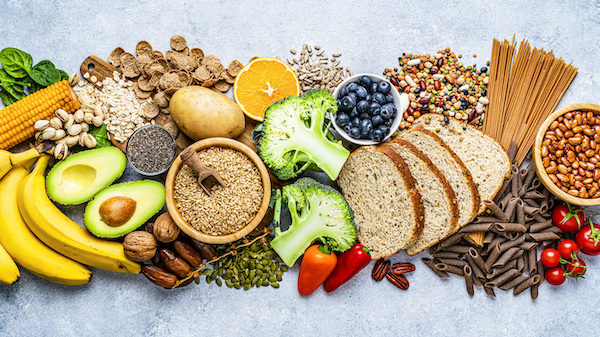Authored by Dr. Sharon Stills, NMD
The glycemic index (GI) ranks foods numerically according to their potential to increase levels of both blood sugar (glucose) and insulin. It measures how rapidly a set amount (50 grams) of a certain food is converted into glucose when compared to 50 grams of white bread, which has a GI of 100.

Following the GI can help you keep blood sugar from spiking too quickly and overloading your cells with glucose. Over time, maintaining well-balanced blood sugar can prevent and/or reverse insulin resistance. Insulin resistance is a problem that can lead directly to metabolic syndrome and type 2 diabetes.
Generally foods fall into these categories:
- GI of 55 or less is considered low-glycemic.
- GI of 56–69 is considered moderate.
- GI of 70 or above is high-glycemic.
Our abbreviated glycemic index chart below will help you get an idea of how foods are categorized. Using the glycemic index can guide you to make good food choices that will help keep your insulin levels steady.
Glycemic index versus glycemic load
The GI of a single food can vary depending on how it was grown, processed or prepared (see GI table below). In addition, because we’re all unique, our bodies respond to foods differently according to our metabolic make-up, when and how much we eat, and how we combine our foods.
Plus there are inconsistencies in how the glycemic index is calculated. Since the glycemic index is based on such a small quantity of food (50 grams) — less than the amount you’d typically eat — some experts say it understates the impact high-carb foods have on your blood sugar, while overstating the impact of low-carb foods.
That’s why some nutritionists developed a calculation for glycemic load (GL) that measures the impact a food has on your blood sugar. It may be easier for you to use GL as dietary guide instead of the GI because GL accounts for the amount of a certain food you are consuming as well as the other foods you eat at the same time.
Here’s the formula:
Divide the GI by 100 and multiply it by the grams of carbohydrate in the serving size.
The glycemic index and glycemic load can help you combine the four food groups in a healthy way. For example, you can see why a scoop of ice cream, which has protein and fat in it, has a lower GI and net glycemic load than a handful of Cheerios, which is mostly refined carbs.
Even the GI on its own can help you make appropriate food choices without resorting to counting carbs. It’s not perfect but the glycemic index can still help keep insulin resistance at bay.
How using GI and GL can help with hormonal balance
Many women experience powerful cravings for high-glycemic index foods when their hormones fluctuate, especially premenstrually and during perimenopause. Since highly refined and processed foods are so readily available, it’s easy to be tempted.
This becomes even more of a problem as we move through life, because a diet high in refined carbohydrates and high-glycemic foods can lead to inflammation, hormonal imbalance, worsening insulin resistance, prediabetes and, ultimately, type 2 diabetes. Your body is also less able to tolerate carbohydrates as you hit midlife which can lead to health issues, including weight gain.
The following chart only contains a very small sample of foods. For a more comprehensive listing, refer to the International Table of Glycemic Index and Glycemic Load Values (2002).
Glycemic Index table
Low glycemic:
|
Low to moderate glycemic:
|
Moderate to high glycemic:
|
High glycemic:
|
Why GI is just one way to choose healthy food
Just because a food ranks relatively low on the GI doesn’t necessarily mean it’s better for you than one that ranks high. For example, a candy bar may rank below a sweet potato on the GI, but the sweet potato has micronutrients that compensate for its high sugar content. Keep this in mind when you’re choosing foods using the GI chart.
For women, selecting low-glycemic index foods is a big help when it comes to creating and maintaining good blood sugar balance. And if you are at risk for insulin resistance, it can make a world of difference in your metabolic profile.
Chart based on Foster–Powell, K., S. Holt, & J. Brand–Miller. 2002. International table of glycemic index and glycemic load values. American Journal of Clinical Nutrition, 76 (1), 5–556. URL: https://www.ajcn.org/cgi/content/full/76/1/5 (free full text; accessed 03.28.2007).
1 Mercola, J. Breast cancer risks grow with high-carb diets. URL: https://www.mercola.com/2005/apr/27/breast_cancer.htm (accessed 03.28.2007).
2 Mendoza, D. 2007. Revised international table of glycemic index (GI) and glycemic load (GL) values — 2002. URL: https://www.mendosa.com/gilists.htm (accessed 03.28.2007).
3 Franz, M. 2003. The glycemic index: Not the most effective nutrition therapy intervention. Diabetes Care. 26 (8), 2466–2468. URL: https://care.diabetesjournals.org/cgi/content/full/26/8/2466 (free full text; accessed 03.28.2007).
4 Gilbertson, H., et al. 2003. Effect of low-glycemic-index dietary advice on dietary quality and food choice in children with type 1 diabetes. Am. J. Clin. Nutr., 77 (1), 83–90. URL: https://www.ajcn.org/cgi/content/abstract/77/1/83?
https://www.ajcn.org/cgi/content/abstract/77/1/83?ijkey=20c43fcea5d788118b0f157b95df5849dc204307&keytype2=tf_ipsecsha
(free full text; accessed 03.28.2007).
5 Mann, J. 2003. Meta-analysis of low-glycemic index diets in the management of diabetes: Response to Franz. Diabetes Care, 26 (12):3364; author reply 3364–3365. URL: https://care.diabetesjournals.org/cgi/content/full/26/12/3364 (free full text; accessed 03.28.2007).
Further Reading
The Glucose Revolution: The Authoritative Guide to the Glycemic Index, by Jennie Brand–Miller, PhD; Thomas Wolever, MD, PhD; Kaye Foster–Powell; & Stephen Colagiuri, MD NY: Marlowe & Co.










